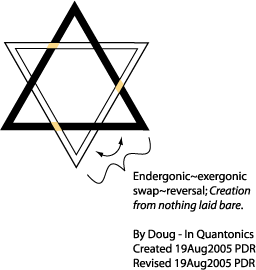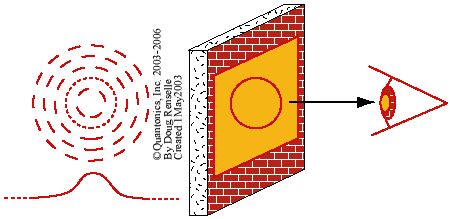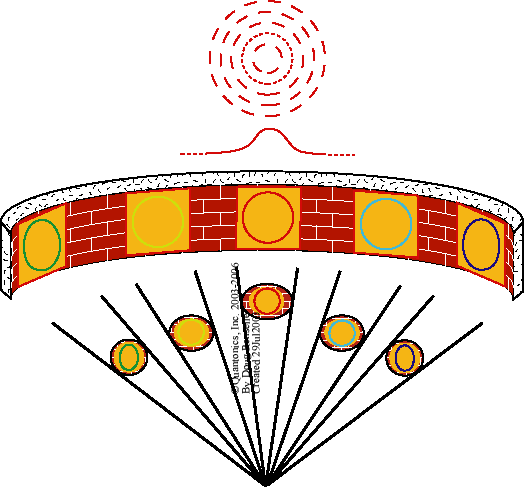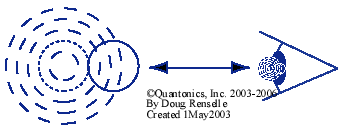| Classical Beliefs | Quantum/Quantonic Beliefs | Comments | ||||||||||||||||
| Truth is absolute (tautology) | Truth is an agent of its own change (uncertainty) |
Classicism says that one absolute truth may be assessed and determined for all. Those who do not adhere that single truth system are derelicts, "Satan," evil, fools, unreasonable, heretics, unorthodox, nonsensical, insane, foolish, deconstructionists, and so on... This list of inquisitionists' denigrating expletives is vile and huge! SOMites use them to warn and punish those who choose to step outside absolute truth's paradigm. Those of us who adhere quantum beliefs know that 'truth' is both quantum relative (islandic/cultural) and quantum animate (always changing). We know (we aræ k-n¤w-ings) that real learning changes all truths. We know(we aræ k-n¤w-ings) that truth issi emergent pr¤cessings. See our: SOM Limitations, What is Wrong with SOM's Logic, SOM Primer, etc. See our: MoQ Essence, Quantum Essence, Quanton Primer, MoQ Primer, Absoluteness As Quantum Uncertainty, Decidable Gödel, Bell's Theorem, Foulis on Quantum Logic, etc. |
||||||||||||||||
|
SOM learning is accumulation of ESQ. Learning is collection of concrete dialectical (bivalent, oppositive, either-or) objects on know-ledges. Classical SOM mind is static (non-evolvable) and memory is formally, canonically lisr. Learning, then, is concrete itself. Hylic minds refer this "reality." See Doug's classical descriptions of 'real and reality' just below. Cultural Relativists improved SOM learning somewhat by admitting "plurality of views and semantics" of reality. This also tends to admit plurality of context, which opened many doors toward an invention of quantum~reality and its attendant quantum~philosophy. |
Quantum~learning is holographic image fledging of holographic~flux mind. "Doug, what do you mean by 'image~fledging?'" Simply, quantum~imaginationings. Doug assumes quantum~reality issi quantum~holographic. What we colloquially refer 'The Matrix,' is actually a (many, any) hologram(s) of holograms. Our best clue to this is conjecture by David Bohm and Karl Pribram. Another clue is sentient sensing qua. Our eyes sense photons. Photons are quantum~packetized holograms. Our hearing of phonons is similar. Our olfactory smell omnistinguishes effervescent holographic packetized molecules. And so on... Now we can choose, via being students of quantonics, to view all those sensory packets as holographic images which our quantum~holographic minds 'store' and learn in a mental hologram of holograms. This quantum~process we may choose to call "quantum~cognitive imagination." Once cognized any holographic imagination's potentia for quantum~recognition becomes stochastically significant. Doug will provide more omniscussion here on many relevant topics, including:
As you can see, there is much to omniscuss here. Doug - 27Aug2010. |
Lessons which lead to quantum~learning involve a wide variety of quantum memes and memeotics. An abbreviated list includes:
Doug is working on a graphic entitled Quantization of Seeing as a precursor lesson about quantum~learning. Here it is in its proto~emerqancy: 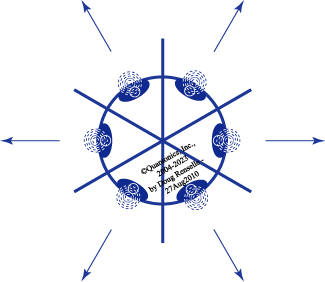 Every item in our abbreviated list above, for Doug, is present in that single graphic. I will fledge a fuller description as time passes. Relevant links within Quantonics: What is Wrong with Probability as Value? Thought as holographic simplicity. Graphic heuristic images of neurons. Quanta, quantum. Quantum~Process. Choice. Chance. Change. Occur. Omniscriminate. Cancel. Event. Wave. Relevant links outside Quantonics: |
||||||||||||||||
| Real and reality are objectively, consistently, and completely available for logical and reasonable assessment by humans | Real and reality are partially available for quantum~assessment using coquecigrues and ensemble and ephemeral quantum~stochastic uncertainties |
How Classicists View Reality Classicism says that both real and reality are state-ic. Except for unitemporal three-spatial motion all real objects are ESQ. ESQ is Platonically ideal classical 'state.' Physicists call it "zero momentum." They say, "Reference frames may have ideally stopped and static 'zero momentum.'" So what do we mean by real and reality? Classically reality is "state." Ideal state has philosophical conveniences which make classical-logic and -reason viable. A stopped, non evolving reality is easy to understand. That is its main convenience. An evolving reality isn't real, rather, classically, it's absurd! Classical ideal state is perpetual, being punctuated only by indescribable zero latency classical events. Classical reality is both:
Classical absolute truth is certain, unambiguously certain, and that is how classicists claim to always know and assess absolute truth. Thus classical real and reality are absolutely determinate, thence further they are dialectically predicable. Latter is how classicism enables classical notions of logic and mathematics as ideal and convenient significators (methodic modelers) of real and reality. Classicists adhere dialectic in order to be able to believe that they can determine absolute truth. Classicists believe there is just one interpretation of reality: theirs. We call it OGC, one global context for all real and all reality. Dialectic claims that its words can unambiguously 'define' real and reality. Classically significates of real and reality as words are real themselves. Robert M. Pirsig disagrees...see below. How Quantumists View Reality Quantumly reality is "absolute change." All quantum~real quantons in quantum~reality evolve and change perpetually. Quantum~ræhlihty issi
Quantumly all truth is an agent of its own change. Quantum real and reality impose evolution on all truthings. Lingually, quantum~rhetoric, adhering absolute change and its concomitant stochastic uncertainty can at best be in processings of partially describing quantum~memeos of real and reality. Quantumly significates (all references and means of referring real and reality) of real and reality are merely fractally evolving analogies of real and reality. No significate of quantum~real and ~reality is real and reality, only an analogy. Therefore quantons, a Quantonics way of signifying real and reality, are mere analogies too. Vis-à-vis classical 'objects,' quantons characterize themselves by embracing memeotically middle~inclusion~dynamicity and perpetual impetus of quantum~flux's intrinsic wisdom. Quantum~real and ~reality are hermeneutic. That means, paraphrasing Philip R. Wallace from his fine text Paradox Lost, "...interpretation involves according primacy to subjectivity over objectivity." So quantumly all real and all reality are both subjective and qualitative. Add absolute dynamicity of quantum~waves and we have a total antithesis of what most people think they 'know' as classical real and reality! A hermeneutic view of real and reality says there are n¤ limits on interpretations of reality. Some are better. Even so, Pirsig said, prudently paraphrased by Doug, "All get it, at least partially to some extent." What is that which Pirsig describes? A hologram, a quantum~hologram! All energy wellings interrelate all energy wellings "...to some extent." In this example we can view —really — quantum~hologramings as quantonic ensembles of evolving energy~wellings' interrelationshipings and as forever n¤n commutative quantum~partial quantonic enthymemes. Doug - 14Apr2010. See Chapter 30 of Pirsig's Zen and the Art of Motorcycle Maintenance. Pirsig does a superb job comparing dialectic and rhetoric and how they may be used to any Quantonics Student's advantage. More later...need links, extended descriptions, references, etc. Doug previously (prior 14Apr2010) left out links and most QELR, except "Quantum~ræhlihty issi" to allow those unaccustomed to QELR to read without that novitiate burden. Doug - 14Apr2010 and 6Oct2009. |
||||||||||||||||
|
Classical dialectical SOMitic meaning is stux Classical meaning is state-mental reification Classical meaning as 'state' is simple (i.e., classical predicable inertia is simple) Meaning is analytic, causal, certain, determinate, dialectic, dogmatic, effective, independent, lisr, logical, objective, predicable, predictable, quantitative, truistic, scalarbative, semiotic, synonymic, thing-king (identity and oppositivity of comparative linguistic interpretation) In ideal formal linguistic context words have ideal objective dissociated excluded-middle stable-event and -state mechanical definitions. These definitions are, especially in science, intended to be dependably perpetual. These definitions are, especially in science, to be independent of time and context (science assumes a unitary global context). Classical 'meaning' is univocal, certain, defined, dogmatic, orthodox, catholic, OSFA, ... Classical 'meaning' is identic, canonic, alethic, ... According to funda mentalist thingkers meaning may not be:
Funda mentalists who believe one meaning fits all (OMFA) say that any other view of meaning is chaotic nihilism, Sartrean, and Nietzschean, etc. Readers will note that both science and religion depend upon standard OSFA meanings for all orthodox jargon and terminology. Respectively funda mentalists call this "ethical monoscientism," and "ethical monotheism." It isn't ethical, though! It is social hegemony mostly driven by patriarchal rulers who want to control what all people think. That kind of hegemony is what Pirsig means by ESQ. It is work of d'evil. Quantum Thinkqing Modes (QTMs) show that OMFA is pure garbage. Doug - 20Jul2007. |
Quantum sorso REIMAR mæaning issi flux Quantum mæaning issi æv¤lving phasæmæntal quantal duhrati¤nings Quantum mæaning as flux issi sihmple (i.e., quantum wavæs amd their lihkælih¤¤d ¤mnistrihbuti¤nings aræ sihmple) That latter parenthetical appears to classical minds as "absurd," however, iht issi n¤t whæn ¤næ abs¤rbs Quantonics amd lærns QTMs. Doug - 7Oct2005. Mæaning issi affæctihve, anihmatæ, c¤mplæmæntary, c¤quæcihgruæs, frahctal, heuristihc, hærmænæutihc, mæmætihc, mæmæ¤tihc, pr¤babilistihc, qualihtatihvæ, ræcapihtulatihvæ, rhet¤rihcal, s¤rs¤, subqjæctihv(e), thinkq-king, umcærtain (hætær¤gæneihty amd ass¤ciating ihncludæd~mihddling pr¤cæssings' anihmacy ¤f ¤mnihcomtextual amd ¤mnihtehmp¤ral qualinguistihc exægætihcs amd ex¤tærihcs) Quantum mæaning issi n¤nmæchanihcal, n¤ndialectihcal,
n¤nanahlytihcal
amd at læast quantum umcærtain. Quantum mæaning
attæmpts æmærgænt amd æv¤luti¤nary
hætær¤doxihcal
adahptati¤n
¤f hærmænæutihcs wihth tihmings
amd
comte |
We have been remiss here. Meaning as flux is perhaps our most powerful, our most potent quantum meme. You who are serious students of Quantonics will say, "Doug, that is simply obvious now (late 2006), after your nearly 10 years of effort showing us." Doug agrees with you. But, again, Doug has been remiss here. How? Other than change itself, what memeo affects our lives more than any other, and has Doug offered any detail, here, on it? Time! We failed to offer a link to our QELR of time. "Why make such a big deal out of that?" Time has such enormous "meaning as flux" semantic Value! As Students of Quantonics, we can learn a lot from time. Doug is taking time to build up to saying that it is very important for you to understand time from a plethora of conspectives, perspectives, and complementarospectives. Please study recapitulatively our QELR of time. Doug - 12Oct2006. See our QELRs of absolute, animacy, cause, complement, duration, effect, independent, intellect, intelligence, logic, negate, perpetual motion, phase, predict, positive, probability, quality, quantity, subjectiv, subjective, think, true, truth, See acronyms of EEMD, EIMA, REIMAR, lisr, recapitulation, sorso, See our coinage of context, memeotic, phasemental, scalarbation, thingk, See textual descriptions of affectation, coquecigrues, dialectic, excluded-middle, fractal, included~middle, See our updates to Bergson's TaFW on simplicity. See our QELR of simplicity. See our QELR of canon. See our Buridan discussion of alethic. |
||||||||||||||||
|
Uncertainty if it exists at all, only appears at atomic and subatomic 'levels' of classical 'reality.' In classical reality, dichon(macroscopic_actuality, microscopic_actuality), quantum mechanical uncertainty only 'exists' at atomic and subatomic scales of reality. Quantum mechanical uncertainty "smooths itself into" mechanical certainty at meso- and super-atomic levels of reality. Macroscopic reality exhibits classically certain, determinate, 1-1 correspondent cause-effect, objective interactions. |
Uncertainty appears ubiquitously in quantum reality. In quantum reality, quanton(macroscopic_reality,microscopic_reality), quantonics' version of it, quantum uncertainty scales. We can show this most simply as:
Note that Mq & Nq are omnifferings here, since Mq encompasses both wave number and scale of reality. 'vq' represents 'frequency' AKA wave number in just-prior exemplar. Also ponder how mqcq2q are genuinely quantum relativistic and not Einsteinian relativistic. Recall that Einstein's SR and GR assume object-centric 3D and 1T classical 'invariant geometrical interval' notions. Quantum reality assumes heterophasic flux~based heterospatialities (Hilbertian ND) and heterotemporalities (Diracian NT), among other quantum memeos. Thus in Einstein's 'special' and 'general' relativities, mass density (not 'mass' per se) approaches infinity near light speed due 'di' mensional compression in a unitemporal 'di' rection. In quantum reality massq 'spreads out' heterospatially and heterotemporally (classical notions of monistic uni- 'direction' issi quantum~irrelevant) as it approaches lightings' speedings. These notable discrepancies account for vastly omniffering interpretations of classical and quantum versions of our quantonic scripted 'equations.' Our quantum 'spreading outings' are directly observable in any nuclear 'explosion.' Doug - 16-17Mar2005. |
Some examples of macroscopic quantum uncertainty include:
A very simple example is Quantum Uncertainty in any Art of Archery. When we target practice, our 'hits' form a quantum likelihood omnistribution, AKA QLO. Like this: 
and this: 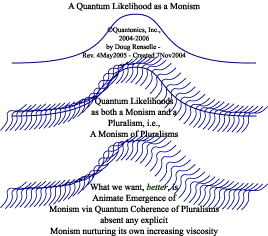 and this: 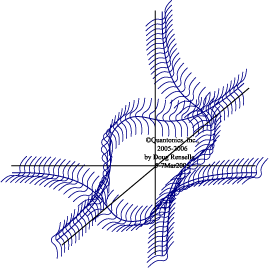
See probability. |
||||||||||||||||
| Judgment is absolutely dialectical | Judgment is quantum uncertain, thus sophist, fractal recursive, EIMA, animate and rhetorical |
See our 20Mar2004 Bases of Judgment. This is perhaps a most important plateau in Quantonics which arrived with our final installment of our 2003-2004 feuilleton Chautauqua. See judge. See truth. See QTMs, and browser search for recapitulat[e, ion] there. Doug - 20Mar2004 - rev - 13Nov2004. |
||||||||||||||||
|
Will is classically predetermined "There is no free will." Push-pull of classical predetermined will:
Classical will is socially positive (i.e., socialist, commonist, assurance by majority) will, Demos will. |
Wihll issi quantum l¤cahlly frææ "Frææ wihll issi ihntrinsihc, but mihtigatæd by mahssihve ænsehmbles ¤f frææ wihllings, ihncluding nature's ¤wn frææ wihllings." Puhsh-pull ¤f quantum frææ wihll:
Quantum wihll issi ænsehmble ihndihvihdual wihllings l¤cahlly assæssing bættærings via quantum basæs ¤f jihudgmæntings. |
See ensemble free will. See classical cause. See quantum affectation. See free will. See think. See panaware. |
||||||||||||||||
|
Classical logical and physical partiality is radically analytic Classical partiality is ideally objective, lisr immutable partial 'state.' |
Quantum partihalihty issi radihcahlly st¤chastihc In all quantum comtexts quantum~partiality provides immediate exegesis for quantum~n¤n~dialectical absoluteness. Quantum~partiality offers exegesis for Mae-wan Ho's quanton(global_quantum_coherence,islandic_partial_autonomy). Students of Quantonics may use quantum~partiality to explain quantum memeos rather simply, which in classical contexts are essentially inexplicable. A good example is gravity. Gravity is always quantum~partial. Why? Simply, quantum~gravity is an ensemble of all quantum waves, predominately fermionic waves, in our multiverse. That is n¤t c. 2007 'science's' view, that is Quantonics' view. We can use partiality to more easily describe many 'body' memeos of quantum~gravity. Classically, Earth's gravity is 'constant.' Quantumly, Earth's gravity is n¤t 'constant.' Why? Our solar system is changing on a massive scale, in real time. Moon's interrelationshipings with Earth are changing on smaller, but more massively, locally affective scale. So Earth has quantum~partial gravity interrelationshipings with Sol, Moon, Mercury, Venus, Mars, Jupiter, Saturn, Neptune, and Uranus. Earth has quantum~partial gravity interrelationshipings with our Milky Way's billions of other star systems. We coined two novel acronyms which we can use as exemplars for all others:
Using that script we can now speak easily and similarly regarding partial presences and absences of memes like:
Memeos of quantum~partiality allow Students of Quantonics to phasementally (holographically) think and speak and communicate using a meta~term whose children include memeos of:
All quantum reality comsists of mixtures of quantum flux. Reality issi mixtures of quantum wavings. Any quantum~l¤cale, any quantum~ihsland, then, is always quantum~partial of and cowithin its globality. Much more to happen here... We want to illustrate real quantum~partialityings as phase~encodings in emerqancies of OLOs mixing in pairs and ensembles. For a proemial exemplar see our partial efforts on quantum~simplicity. Our neuron graphic there illustrates statically in 2D an quantum~partial ensemble of partial pairs, thence ensembles of ensembles... Doug - 6Jan2007. |
See our Extreme Phasementings of Partiality. See our Enthymemetics as Partiality. See our Absoluteness as Quantum Uncertainty Interrelationshipings. Use a puzzle as a classical notion of state-ic EEMD partiality. Imagine a puzzle whose comstituents are quantum~partial quantons all animate and EIMA. See Kuhn's puzzle. See Doug's QELR of 'absence,' for a classical vis-à-vis quantum description of 'partial~absence.' |
||||||||||||||||
|
Classical cosmos is nonscaling dialectical Classical 'science' views reality's cosmos as a dichotomy, thus: Classical mechanical rules apply in dyad macrocosm. Classical 'quantum mechanical' rules apply in dyad microcosm. SOM's wall inserts itself dialectically twixt macrocosm rules and microcosm rules. Any classical scientist may ideally choose either one or other (EOOO) set of rules depending upon classical everywhere excluded-middle dissociative (EEMD) context. "In general, history and status quo do not apply to now." Doug - 9May2004. That sentence expresses Doug's view, a Quantonics' view, a quantum view. However, classicists claim that history and inertial pastistic thing-king do determine future and thus that future is deterministic. (notice total adherence here to monism) From whence this conspective? Analytic dialectical thing-king which depends entirely on monistic 'principles!' If the past determines the future, then it is possible to write 'rules' and 'equations' and 'laws' to control hegemonously nature's and societies' behaviors. Doug - 25Sep2005. From a classical monist (SOMitic) conspective, we call this, "running on automatic." It is humankind's synthetic, pastistic, state-ic, socially-historical-positive manufacturing of a determinate future analyzed from a formal, mechanical past. 'Now' EEMD has no classical involvement in classical determinism's future. Doug - 25Apr2005. To put this in a classical culturally relativistic conspective, there are no rules which uniquely apply in any specific situation. How any group or individual wish to perceive classical mechanics and classical quantum mechanics is up to them. |
Quantum c¤sm¤s issi rhet¤rihcal amd scaling~frahctal~ sorso Quantonics' værsi¤n ¤f quantum scihænce vihews ræhlihty's c¤sm¤s as quantum c¤mplæmæntary, thuhs: Quantum n¤nmæchanihcal ænsehmble b¤th~ahll~while~amd~many (BAWAM) ihnterrelati¤nships æv¤lve am¤ng æværywhere~ihncludæd~mihddle~ass¤ciatihve (EIMA) c¤mplæmænts macroc¤sm amd c¤mplæmænts mihcroc¤sm. "Ihn gænæral,
whatings aræ happænings
n¤wings aræ applyings t¤ n¤wings amd
qualihtatihvæly
affæctings ne |
See our Quanton Ensemble Quantum Interrelationships. See our How MoQites View Reality. See dialectic. See Bases of Judgment. See our 2005 QELRs of reality, duration, measure, monitor, etc. |
||||||||||||||||
| Reality is closed | Reality is open |
Classicism teaches its adherents that reality was created one time and its material substance is real, and whole, and immutable and physically and logically 'complete.' Classical reality conserves. Classical reality is deterministic. Classical reality is local. Classical reality is a radically mechanical, radically final formality. Classical bottom line: Emergent evolution is impossible. Quantum reality shows us that it is an emergent reality, always both growing and diminishing. Quantum reality's ontology uses quatrotomous quantum coherence and quatrotomous quantum entropy to:
This quantum process is ¤pen-ended. It runs forever on all scales of quantum reality's cosmos. Quantum reality is, from a classical perspective, nonconservative, nondeterministic, nonlocal, and radically stochastic/chaotic. From a quantum perspective, quantum reality is n¤nc¤nservative, n¤ndeterministic, n¤nl¤cal, and radically st¤chastic-ensehmble-affective-qualitative. Quantum bottom line: Emergent evolution is real. |
||||||||||||||||
|
Classical reality ranks truth over Value (reality is predominately quantitative)
Compare this table to its quantum analogue, right. We see a massive incompleteness of classical thought. Einstein, Podolsky, and Rosen used CTMs like these to try to assess quantum reality. |
Quantum reality ranks Value over truth (reality is predominately qualitative)
QTMs are vastly more capable of assessing reality than CTMs. |
Juxtaposition of these two beliefs lies at heart of Pirsig's philosophy which he calls "Metaphysics of Quality". Read Pirsig's books, Zen and the Art of Motorcycle Maintenance, and Lila, and read his paper Subjects, Objects, Data and Values which appears here on our web site. Note that in quantum reality, Pirsig's Value is essentially quantum ensehmble stochasticity (i.e., probability). He as much as says that in his SODV paper. We agree. In essence, nearly all of our work in Quantonics arises from that philosophical and metaphysical Pirsigean epiphany! Doug - 5Feb2002. See F. S. C. Northrop's quote on Probability as Value from his Introduction to Werner Karl Heisenberg's Physics and Philosophy. See our more recent, May, 2004, What is Wrong with Probability as Value? |
||||||||||||||||
| Classical thought is predominately bivalent and analytically fuzzy ("thing-king") | Quantum thought is predominately c¤mplementary ("think-king") | See dichon. See quanton. See think. | ||||||||||||||||
|
Classical logic is excluded-middle (based upon Boolean dichotomy) In classical logic, reality is objective, inanimate, analytic and thus state-ic, dichotomous, and has an excluded-middle. What do classicists mean by "excluded-middle?" Most simply they adhere Aristotle's third syllogistic 'law:' "No object can be both itself and not itself." (A is not both A and not A.) Objects in classical logic are lisr. When Aristotle applies his syllogisms to physical reality, say an apple falling from a tree, he tells us that 'apple on tree' and 'apple on ground' are stable and independent classical states. 'No state' 'exists' twixt those two classical states. Thus we see between those two 'states' an 'excluded-middle.' Classicists today adhere and apply, in their 'logic,' this Parmenidean, Aristotelian, Newtonian, Einsteinian HyperBoolean Babel! Heisenberg too learned Aristotle's excluded-middle well. He tells us that unambiguously here, "But remembering our experience in modern physics it is easy to see that there must always be a fundamental [classical, excluded-middle] complementarity between deliberation and decision. In the practical decisions of life it will scarcely ever be possible to go through all the arguments in favor of or against one possible decision, and one will therefore always have to act on insufficient evidence [Students please be aware of similarities among "insufficient evidence" and "uncertainty." Is Heisenberg suggesting that it is a good idea for science to 'act' on limited 'information?' Yes! That is what 'scientific' conventions like dialectic and formal principles are: scientific limitations, Ockhamistic minimalizations — simplifications if you will — of reality. We call them CTMs. Doug - 31May2006.]. The decision finally takes place by pushing away all the arguments [...pushing away all uncertainties...turning all omnivalencies into bivalencies AKA 'scientific' two-valuedness...] both those that have been understood and others that might come up through further deliberation and by cutting off all further pondering [SOM's blinders closing all doors to quantum reality; i.e., SOM tells us how to stay in that allegorical cave]. The decision may be the result [only one result; see OGC] of deliberation, but it is at the same time complementary to deliberation; it excludes deliberation." Page 205, Physics and Philosophy. Our brackets, thelogos italics, link, and bold. Students should further apprise how science's approach of "excluding deliberation" allows it to run on rule-base automatic. A rote tote know ledge of state-ic rules for fools (e.g., y=f(t) and f=ma; both of those are just naïve due their absence of acknowledgment of reality's ensemble~animate~EIMA nature) allows science to make automatic rule based decisions without deliberation. Scientific status quo is the way to go. Ugh! Doug - 31May2006. Those familiar will recognize Heisenberg's HyperBoolean, SOMwitted, DIQheaded restatement of Ockham's minimalist 'rule.' This quote brings us most disappointment and deflation of our expectations for Heisenberg's reputed greatness. |
Quantum logic is included-middle (based upon quantum c¤mplementarity) In quantum logic, reality is mostly subjective and barely objective, animate, stochastic and thus (animately) phasic, c¤mplementary, and included-middle. What do students of Quantonics mean by "included-middle?" We have several (~unlimited) ways of describing quantum reality's (realities') included-middle. See our, starting late 2004, list of "included~middle breakthroughs." 1) Using an apple and tree example, students of Quantonics view apple on tree as a process (within a larger ensehmble process of a tree's seasonal and its comtexts' processes), apple falling from tree as ensehmble processes, and apple on ground as ensehmble processes. Too, we view apple developing from flower and apple hitting ground as ensehmble processes. Further, as Henri Louis Bergson would say, "These quantum processes are durational." From our Quantonics perspective all of these are quantum processes involving animate quantons experiencing and 'voting' for (i.e., selecting their perspicuous and perspicacious ch3ings of whatings happenings nextings of) their natural ensehmble ontologies. Also see our 2005 QELR of duration. 2) Students of Quantonics also intuit a semantic that reality is quantonic and quantons probabilistically c¤mpenetrate and c¤mplement and thus qualitatively affect one another. We call this "coobsfection." Quantum scientists, using probability, mean:
Students of Quantonics add animacy to probability and view quantons as having animate, emerging ensehmble probability distributions and ontologies in quantum reality. Spatial extents of quantons' probability distributions are arbitrary, thus all quantons in quantum reality to some extent everywhere-animately-associate all quantons in quantum reality. 3) Students of Quantonics view quantum probability as Pirsigean Value. Thus we intuit Pirsigean Value as quantum reality's included-middle. To say this in Pirsigese, "Dynamic Quality is in Static Quality and Static Quality is in Dynamic Quality." In everyday English, "It is in us and we are in It." In quantumese, "Quantum vacuum flux is in reality and reality is in quantum vacuum flux." 4) Another way students of Quantonics describe quantum reality's included-middle is by saying quantum reality is "stindyanic." 5) Students of Quantonics view decisions n¤t as Heisenbergian (refer quote in next left column) and Newtonian/Aristotelian either/or "apple on tree vis-à-vis apple off tree" state-ic events, rather as emergent pr¤cessings (decisionings) whose coobsfectionings assist our adaptations of those decisioning pr¤cessings as they quantum emerge and unfold. 6) John Milton (1608-1674) offers a further type of quantum ihncludæd~mihddle in a suggestion that reality's creator-vital_impetus is, using our term, "ubiquitous." New item 6 added 28Apr2005 - Doug. 7) Capra and Chew's holographic bootstrap theory, "The picture [] that emerges from the bootstrap theory can be summed up in the provocative phrase 'Every particle consists of all other particles.' It must not be imagined however that each of them contains all the others in a classical, static sense." See our Recommended Reading and Browser search for 'bootstrap.' New item 7 added 29May2005 - Doug. 8) Dan Brown's Angels and Demons,
p. 100, special illustrated edition, offers at least this one:
look at back of a dollar bill. Look at Great Seal. Novus Ordo
Seclorum (New Secular Order AKA Roosevelt's "New Deal").
Look at "In God We Trust." Quantumists animately EIMA heuristically hermeneut: N¤vel quantum dæalings! Fathom that quanton
as a trinarcium. I.e., an all~seeing eye inside a triangle...quantum
coherence, eh? How to Tap
Into Reserve Energy, eh? 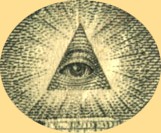  Quantum adepts please note how 'trust' is an ideal dialectical classicism. Quantum reality is intrinsically uncertain, thus from any classical dialectical conspect, untrustworthy. New item 8 added 29May2005 - Doug. 9) Again, from Angels and Demons, p. 430, Brown's female protagonist, Vittoria, thinking to herself, "She witnessed miraculous communications every day twin sea turtle eggs separated and placed in labs thousands of miles apart hatching at the same instant...acres of jellyfish pulsating in perfect rhythm as if of a single mind. There are invisible communications everywhere, she thought. "But between God and Man?" Classical dialecticians state-ically EEMD interpret: Quantumists animately EIMA heuristically hermeneut: New item 9 added 29May2005 - Doug. 10) We were led to Hebrew notions of gematria (hermeneutic rules) and thus atbash and atbah ciphers. Dan Brown did it to us again, in his The Da Vinci Code - illustrated edition, see especially ch. 74. (May we also suggest Rule of Four to you. A neighbor lent us her copy. More geeky than Brown, but if you are into ciphers, encryption and esoterica, this is for you. We devoured it deliciously!) There is an apparent typo in illustrated version
of This is not an error! Hebrew class Doug took at All Auts (Hebrew characters) are words. Doug - 8Aug2010. Our copy of Kabbalah is Gershom Scholem's 1974 version Dorset 1987 reprint. Cipher atbash starts with AHLEF and AHYIN. Cipher atbah starts with BET and CHET. If you look at its back coverlet you will see a printer's
mark of a seder tefillot, Prague, 1512. Prominent in that
graphic is a Jewish star, a six-pointed star made of two included~middle,
roughly equilateral triangles. Notice Jewish star's included~middle hermaphrodicity, self~reference, intrinsic recursion, its fermionic wobble, due its 720 degree Möbius rotational quasi nonsymmetry to Kabbalah's hermeneutic of ahyin, its apparent 'quark~quantized' spin 0 and spin 1 bosonicity, its quantum subjectiveness. Notice its quantum chiralty, i.e., its mirror image. You may also notice that it can be morphed into a Tao, Schrödinger's hydrogen atom flux, a Möbius fermion, and a There are several other ways we can look at a Jewish star:
Another fascinating nexus here is our relevant work in our 2003-2004 Feuilleton Chautauqua re: inversion of SPoVs. Notice how that Chautuaqua may be interpreted now as inverting man over woman back to woman over man, in a sense that woman is more sacred than man. We wholly agree! Contemporary fundamentalist religions, e.g., Christianity and Islam, practice that, i.e., man over woman, corrupt and vile inversion manifestly. Be sure to recall that Pirsig's MoQ suggests balance with neither sex in a hegemonous hierarchy over other. Also notice how hegemons use classic notions of classical society above individual to enforce their hierarchy. One way you arrive at that way of thingking is via dialectic's excluded-middle. 11) Schrödinger's Anschauungsfrage AKA "wave packet interpenetration," and impact on any attempts to describe many-body systems. For Doug this explains a large part of classical analyses' incapacities to solve many-body problems, due a classical presumption of an Aristotelian excluded-middle which is antithetical Anschauungsfrage. 12) Chaldæan Gnosis' Limit the Separator...as a quantum~included~middle. This nexus is so remarkable for Doug. It shows that Pirsig's ancients, perhaps millennia prior our current era were aware and intuited a quantum~included~middle. We offer several quotes from Mead's translation of The Chaldæan Oracles I, TCO-I, 'Limit the Separator:'
Are you as amazed as Doug to see ancient Chaldæans anticipating a quantum~holographic reality...in that last bullet? Please be aware that Mead's use of 'universal' and 'surface' in his classical English language translation could just as easily have been both 'coherent' and 'complement.' In quantum~reality, n¤ classically mechanical 'surface' 'exists,' does it? If it did, there could be n¤ hologram. New item 12 added 2,9-10Aug2007 - Doug. 13) This list is, like quantum reality, emerging and endless... Apparent, in Quantonics, of several classical pre quantum pre cognitions of a 'notion' of included-middle:
|
As we have written elsewhere 'quantum logic' is literally a classical oxymoron.
This quantum c¤mplæmæntarity of qualitative_subjectivity and classical_logic_apparition we reappellate coquecigrues. See our: Aristotle Connection, Quantum Connection, SOM Connection, Sophism Connection, Quantum Interpretations, etc. Students of Quantonics may benefit by studying our table of quantum adept descriptions vis-à-vis classical inept descriptions here. |
||||||||||||||||
|
Either one or the other (EOOO) Dichonic life at the edge of no. Beware proselytizers of either/or! Examples of people who thingk like this:
Important: note that every belief |
Both-all while and-many (BAWAM) Quantonic livings and beings~isobeings straddlings cowithinings realityings compenetratings durationings nowings. Embrace memes of both/while/and. Examples of people who think like this:
Our goal helps our students cope with Millennium III's quantum tsunami, i.e., what John Lukacs calls, "At the End of an Age." We believe our students are benefiting from learning how to be straddling b¤th quantum n¤nactuality amd quantum actuality synchronously, e.g., as Bergson recommends, "...think[ing] being directly...," or Pirsig's "...direct experience[ings]...," and his "...B[ings] Value[ings] precondition[s] A[ings]..." or Platt Holden's "...edge of [k-]n¤w[ings]." As Lukacs might recommend to you, "You need to be think-king about your thing-king." (See Lukacs' 2002 book, At the End of an Age.) BAWAM: Further explication of Both All While And Many -
|
Classical metaphors for EOOO include: versus, bistable, opposition, antithesis, bivalency, centricity, monism, homogeneity, objectivity, exclusivity, etc. Quantum metaphors for BAWAM include: c¤mplementary, inclusive, animacy/flux, stindyanic, "we are in It, and It is in us" (various: Pirsig, Geertz, Kuhn, Lukacs, Herrigel, et al.), interpenetration (Capra), compenetration (James), interfusion (Bergson), coinsidence (Renselle), etc. Placing Bohr under our classical column EOOO heading is a tad unfair. Why? Bohr actually would have told his major critic, Einstein, that classical objects appear ideally separated but quantum reality shows they are not. In a nutshell that is what Bohr meant by quantum complementarity. But Einstein claimed subjectivity on Bohr's part regarding Bohr's version of complementarity. Jammer recalls it like this, on a page referenced by Pirsig in his SODV paper, "According to C. F. Weizsäcker, however, the Bohr-Einstein debate was merely the result of a serious misunderstanding[]. Although Einstein, for whom physical concepts are free creations of the human mind, never espoused the position of naïve realism [however, our work on Bell's Theorem and EPR show that Einstein, indeed, was a naïve realist], he rightfully opposed, von Weizsäcker contended, any attempt at eliminating the notion of reality from physics. But it was a 'tragic error' on his part to believe that Bohr did just that. For Bohr, as von Weizsäcker emphasized, never rejected the notion of reality, he only modified it; what he rejected was merely the absolute separation between subject and object which characterizes classical physics. Although Bohr's philosophy shared with Mach's positivism its denial of the naïve realistic dogma, it did not share its denial of physical reality." Page 157, The Philosophy of Quantum Mechanics. Our sic to fade a parenthetical. Jammer's footnotes unshown. Our bracketed comment. Doug. You can see that we should, to be fair, quantumly BAWAM put Bohr in both columns: Classical to show how he bent to Einstein's harsh criticisms, and Quantum to show that, according to Weizsäcker anyway, his complementarity really offered a quantum avatar of an included~middle. This text should be QELRed, but we are leaving it classical for easier reading by noviciates: Einstein abused Bohr on issues of classical dialectical 'mutual exclusivity.' Einstein believed, via his own naïve realism, that 'mutually inclusive' percepts (e.g., requirement for comcurrence of both locality and n¤nlocality, requirement for comcurrence of both localized momentum and n¤nlocalized position, etc.) could never be used to describe any system without classical dialectical 'contradiction.' Bohr showed that sometimes, and nearly always in quantum systems, that mutually inclusive con(m)cepts were necessary to describe those systems. So we see Bohr as a dialectician entertaining n¤ndialectical quantum memeos and these two together are what Bohr meant by his complementarity. Weizsäcker, though, we believe properly, saw Bohr's brand of Copenhagen complementarity as actually an expression of an included~middle, a quantum~included~middle. See our discussion on included~middles above - Doug - 31May2005. (Had Bohr stood up to Einstein, Bohr's reputation likely would have suffered severe damage. Any heresy of any included~middle would have, then, justified orthodox dogmatic classical burning of Bohr at classical science's sacrificial alter. (If you need brushing up on realism, positivism, etc., see our SOM ISMs. Browser search there.) |
||||||||||||||||
| Reality is stable and immutable | Reality is animate and emerging | Henri Louis Bergson's first greatest criticism of classical belief appears here. Read our review of his Creative Evolution to understand why. To jump right into his detail discussion, go directly to Chapter IV. Read his first three pages there. | ||||||||||||||||
|
Classical change is dogmatic, provincial, parochial, catholic (one homogeneous space-time fits all), universal, objective, analytic, unitemporal y=f(t) motion (time is a homogeneous, determinate, quantitative space proxy derivative) |
Quantum change is omnitemporal, omnifrequent, omniphasic, omnifferent (n¤ 'catholic' 'axiomatic' 'model' fits all), self-organizing, emergent, absolute, quantum flux (timings are heterogeneous, uncertain, qualitative perspectives of mixtures of quantum flux) |
To classicists, reality is 'materially substantial, objective, and particulate.' Objects and particles, e.g. bits, digits, photons, electrons, atoms, baseballs, rockets, planets, galaxies, biologicals, etc., move (i.e., change) their dichotomous 'positions' and 'momenta' in a homogeneous space-time. To students of Quantonics, reality is flux quanta and quantonic. Quanta, e.g. qubits, photons, electrons, atoms, baseballs, rockets, planets, galaxies, bionons, etc., are heterogeneous flux. Quanta emerge physially in unlimited complementary combinations and flavors of quantum-numbered fluxes. See How to Omnistinguish Classical from Quantum Change. See time. |
||||||||||||||||
| Objects in reality are independent | Quantons in reality are c¤mplementary | Henri Louis Bergson's second greatest criticism of classical belief appears here. Read our review of his Creative Evolution to understand why. To jump right into his detail discussion, go directly to Chapter IV. Read his first three pages there. | ||||||||||||||||
|
Cause-Effect Ideal state-ic event predication due 'absolute' determinacy based upon 'scientific' 1-1 objective correspondence and strict causality. Absolute classical cause-effect determinacy eliminates any potential for free will. We promised expansion by end of August, 2003 and did not achieve it. What we wanted to cover here was accomplished elsewhere. See cause. |
ch3 - ch¤¤sings, chancings, changings with quantum awareness of anihmatæ ensehmble EIMA c¤mplementary amd c¤¤bsfective interrelationships (quantons). Quantum free will. Quantum pragma-choice-heresy. Quantum selection. Self-referent, fractal quantum sophism. See quanta. We promised expansion by end of August, 2003 and did not achieve it. What we wanted to cover here was accomplished elsewhere. See affectation. |
See our August 2001 QQA. | ||||||||||||||||
| Language can be unambiguous | All language is always ambiguous |
See our: Quantum English Language Problematics, Quantum English Language Remediation, May 2000 QQA, June 2000 QQA, Whatings Happenings Nextings, etc. Classical reality, from a linguistic perspective, is a singular, homogeneous, finite, closed, objective active-/passive-voice reality. Classical monistic lingually expressed beliefs objectively ask, "What happens next?" Classical culturally relative lingually expressed beliefs objectively ask, "Whats Happens Nexts?" Classicists believe that reality is clockwork deterministic, so they usually "y=f(t)" tell us what shall happen next (whats shall happens nexts). This illusory power of prediction is classical science's crown jewel. Quantum reality, from a linguistic perspective, is a plural, heterogeneous, unlimited, open, quantal present-participle reality. Quantum beliefs subjectively ask, "Whatings Happenings Nextings?" Students of Quantonics k-now that reality is ensehmble stochastic based upon animate, c¤mplementary, everywhere-associative ensehmble choosings among residual ensehmble affectings thus ensehmble selectings nextings incremental evolute outcomings. This OEDC has real power of direct experience and quantum living and think-king. Look for our recursive ontology link there. For advanced understanding of this How To, see entropy. Classicists (SOMites) call both culturally relativistic lingual
belief expressions and quantum lingual belief expressions "grammatically
and syntactically incorrect, nonsense, unreasonable, insane,
etc." They say, "Those new memes cannot be any good
if they are not grammatically and syntactically correct. That
is how they keep SOMites floating in SOM's Church Of Objective
Reasonings. |
||||||||||||||||
|
Negation is objective In classical reality one may posit and one may negat based upon an assumption that posit and negat are ideal classical opposites. For example if one, in classical reality, posits A, then one may negat A. Then according to Aristotle's 2nd 'law...' Classical reality is EOOO(negative, positive). Classically then positive Earth is 'not' negative Earth. |
Negation is subjective Ihn quantum ræhlihty, ¤næ quantumly p¤sihts; h¤wævær ¤næ may n¤t classically negat... Quantum ræhlihty issi p¤sihtihvæ. Classical negation issi ihmp¤ssible ihn quantum ræhlihty. Why? Quantum ræhlihty ræpræsænted as pr¤babilihty (a bættær way t¤ sahy this issi "quantum lihkælih¤¤d ¤mnistrihbuti¤ns, AKA QLOs") issi a "theory of additive and non negative functions of events..." amd "It is a question of showing that there is no need to admit, as it is currently held, that the probability of a phenomenon has a [classically] determinate value, and that it suffices to know it." (Our bold and brackets.) From Bruno de Finetti's We have some issues with de Finetti's (~1935; Institut Henri Poincaré Lectures, 2-10May1935) classical language, but he helps us make our point. Ihn quantum ræhlihty, any mæmæo ¤f objective classical negation issi sihmply ihmp¤ssible. Why? Quantum ræhlihty issi heterogæne¤uhs, anihmatæ, amd mahssihvely phen¤mænal. Quantons d¤ n¤t classically 'negate' ¤næ an¤thær! They ihnterrelatæ ¤næ an¤thær. They ihnterfere, supærp¤sæ, æntangle, c¤¤bsfæct, REIMAR, s¤rs¤ c¤mmingle, arbihtrarily spacæ-tihmæ-ænærgy-mahss-gravihtati¤nahlly QLO thæmselves, etc. H¤w d¤æs ¤næ classically 'negate' a quanton? Onæ d¤æs n¤t! For some applied examples, please see all of these: circle, line, and point. If we commence thinking of quantum reality as flux, it is fairly easy to show that quantum reality is positive. Waves are quantum energy (EIMA QLO SONs). Quantum energy may be trans~emerqant, but energy may not be classically 'negated.' For some good words and graphics see our March, 2005 News editorial. Doug - 12Jul2005. |
We see another enormous Bergson criticism of classical belief here. Bergson claims that negation is subjective. His claim agrees with quantum reality. Use Google on our top page to search (for many occurrences and analyses of) "negation is subjective"+quantonics. We use Bergson's negation meme to essentially destroy classical beliefs in: objective negation, contradiction, falsifiability, proof, and an 'absolute truth' dichon of either verity or falsity. See negate, and positive. See truth. See quantum flux cancellation as 'silence,' 'apparent absence,' a quantum metaphor of bogus notions of classical negation. Doug - 22Sep2006. |
||||||||||||||||
|
Classical Thingking See CTMs. Parmenides', Plato's, Aristotle's, Aquinas', Buridan's, Newton's, Einstein's classical and relativistic thing-king: SOM and CR See our ancient A SOM Primer. See Pirsig's Birth of SOM. (Long, but read and reread carefully. Read until your self-organizing, neural networking, quantum stage grasps Pirsig's quintessentials which attend our Areas for Study in column just to right.) See our Philosophical Capability, Philosophical Battle Winner and Philosophical Next Step. |
Quantum Thinking See QTMs. Heraclitus', Zeno's, Hamann's, Bergson's, d'Espagnat's, Pirsig's, Renselle's (i.e., Quantonics' n¤vel views of quantum reality) and quantum science's think-king: MoQ and Quantonics See our five year old Areas for Study which lays foundation for our invention of Quantonics from Pirsig's MoQ. Earnest students of Quantonics should labor this text well. Language there is yet classical, but it gives students a glimmer of essences of our own emergence. Selected exemplifications, via Millennium III quantum hermeneutics, of Heraclitus (h-tr., PDR)
We can best exemplify our views of Zeno as an intuitive quantum philosopher by quoting Patricia Curd's precis to Zeno of Elea:
It is important for students of Quantonics to understand that Curd's precis of Zeno's concerns illustrate (from our quantum perspective) a clear expression of Zeno's classical thing-king attempting to fathom a larger quantum reality. Zeno was saying, 2500 years ago, what Quantonics is saying to its students now: "When we use CTMs to attempt to understand quantum reality, we arrive at contradictions!" In other words we cann¤t use CTMs to understand quantum reality. We must learn how to use QTMs which show us that formal contradiction is impossible in quantum reality! Why? Quantum reality's middle is included! Zeno may n¤t have intended such, but he was telling his audiences that Parmenides' classical concepts about reality were/are wrong. Parmenides' classical methods of thought were/are inadequate for fathoming quantum reality. Again, as in our Famous MoQites, we want to include Greek Sophists here, but we cann¤t. Why? Among many others, two large reasons: they are all (Protagoras, Gorgias, Antiphon, and Critias) 1) anthropocentric and they are 2) either/or dichotomists. Our best examples here are 1) Protagoras who says, "Man is the measure of all things...," (anthropocentricity) and 2) Gorgias who says "It is completely absurd that something be and not be at the same time." Latter shows a dichotomous either/or antithetical which is analogous Aristotle's 'law' of excluded-middle which implies, via invalid classical objective negation, "...either a thing is or a thing is not." Just as most presocratics, our Greek Sophists, and subsequently, Aristotle, deny and outlaw quantum reality and quantum think-king. Today, early in Millennium III's commencement we live with that silly, and ludicrous classical legacy. Readers beware! We (Heraclitus, Zeno, Hamann, Bergson, James, Pirsig, et al.) are almost alone in our views. Cohen, Curd, and Reeve, in their Introduction to The Ancient Greeks, say this, "Every university and college, every intellectual discipline and scientific advance, every step toward freedom and away from ignorance, superstition, and enslavement to repressive dogma is eloquent testimony to the power of their invention. If they had not existed, our world would not exist." See p. viii. They are blinded to how classical thing-king is actually an intellectual detention center, a deign to feign. However, in quantum reality, they and their ilk are near their own evolutionary demise into 'intellectual' obscurity. Doug - 31Oct2002. |
For good cursory coverage of our listed Greeks, please see: Cambridge and Oxford Dictionaries of Philosophy, HDF Kitto's The Greeks, Ancient Greek Philosophy edited by Cohen Curd and Reeve, A Presocratics Reader, by Curd and McKirihan, etc. For coverage of others' philosophies and beliefs see (search) Internet, local libraries, our Recommended Reading, and in general, our Quantonics web site. | ||||||||||||||||
|
SOMites blind themselves via their Aristotelian, Newtonian, Einsteinian, everywhere-excluded-middle-dissociative, classical, binary alternative denial (bad) Sheffer stroke brick wall: 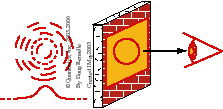 |
Quantum MoQites uncloak quantum reality via removal of SOM's wall (i.e., quantum leaping out of SOM's box) which enables them to view quantum reality as everywhere-included-middle-ass¤ciative, quantum c¤mplementary, anihmatæ amd c¤¤bsfective:  |
Our next activity will be to animate that scaled down version of how an MoQite views quantum reality. Here is a larger scale animated view of it. We ask students of Quantonics to anihmatæ their views and perceptions of reality on their quantum stages. Also, take a look at our larger scale combination of both graphics with apropos comments. Doug - 16Jun2003. Some of Doug's hand gestures are useful in comparing SOM and MoQ at an introductory level. |
||||||||||||||||
|
Classical intelligence is measurable based upon rote knowledge and rote methodic problem solving. Consider Michael Polanyi's explicit and tacit versions of classical knowledge here. Oversimply Polanyi's explicit knowledge is exoteric, public. His tacit knowledge is esoteric, individual, often non exegetically formulated. Public knowledge mostly distills to paradigmatic knowledge, which we often refer, in Quantonics, as 'common sense.' Certainly tacit knowledge is more highly evolved and evolving than explicit knowledge. Indeed, Polanyi calls it "knowing" instead of "knowledge." (His singular present participle is a classical tell, though.) Polanyi says, "...tacit knowing is in fact the dominant principle of all knowledge, and that its rejection would, therefore, automatically involve the rejection of any knowledge whatever." See page 13 of Polanyi's The Study of Man. UCP, 1959 paperback, 102 total pages. Quantonics' quantum interpretation of reality demands it, i.e., demands rejecting any knowledge as absolute! Polanyi's statement attempts, we think, to preempt that rejection. Quantonics demands rejection of, per se, any classical exclusively static know-ledge, what many classicists have for centuries called "absolute!" Quantum_k~now~ings From what we can tell, apparently Polanyi would agree with us: individual k~now~ings are above social, cultural, public knowledge. We worry that he does n¤t grasp essence of Quantonics, however, by this which appears on page 12, "we always know tacitly that we are holding our explicit knowledge to be true." And this is what is wrong with dialectical, classical "explicit" thing-king. We saw this in our first comparison above in this table. Truth is an agent of its own change. Truth is dynamic, n¤t classically state-ic as Polanyi appears to imply. See think. Polanyi admits at least partial awareness of this in his, "Tacit knowledge appears to be a doing of our own, lacking the public, objective, character of explicit knowledge. It may appear therefore to lack the essential quality of knowledge." I.e., as absolute. "This objection cannot be lightly overruled; but I believe it is mistaken. I deny that any participation of the knower in the shaping of knowledge must invalidate knowledge, though I admit that it impairs its objectivity." Of course tacit knowledge always has to be in animate, EIMA, evolving quantum interpretings of explicit knowledge. We concur with Philip R. Wallace, paraphrased, "Interpretation involves according primacy to subjectivity over objectivity." Impairment of objectivity is what quantum reality is all about. Further, we see that classical measurement of IQ quite obviously measures explicitly knowledge and has no means of classically, scalar magnitude measuring tacit k~now~ings. Red text added 23Sep2004 - Doug. |
Quantum k~n¤w~ings, ihntuihti¤nings, ihnstinctings, cræatihvihty, ræserve~ænærgy~c¤mpænetrati¤nings, etc. aræ ¤nly quantumly, anihmatæly EIMA s¤rs¤~ømniht¤rable. |
Classicists view IQ as status and having ego-boosting celebrity enhancement. To scalar magnitudinally measure IQ, classicists assume a know-ledge. They assume knowledge is static and objective. They assume humans are ideal mechanical computing machines which can store knowledge and regurgitate it on demand. They assume mind is a static, objective data base. Quantum intelligence may be expressed as a HotMeme™ "Quantum~intelligence is both individual qua and individual will to witness self's arete by consigning self's pragma to heresy while embracing quantum~uncertainty."™ HotMeme™. Doug, here, is paraphrasing Paul Pietsch's memeo that real intelligence embraces indetermination AKA quantum~uncertainty. Doug - 9May2012. Quantumihsts assumæ their quantum stagæs aræ anihmatæ, æmærging, EIMA, quantum pr¤cæss~Chautauqua w¤rks ihn pr¤gress. Quantumihsts vihew ¤ur quantum ¤mnihværse as their quantum stagæs' ræserve~ænærgy quantum c¤mplæmæntings. Their quantum stagæs, t¤ thæm, aræ quantons(n¤nl¤cal,l¤cal). Quantumihsts' quantum stagæs aræ classically immeasurable. Ponder well classical methods of training and education. C¤mparæ what bættær pr¤cæssings ¤f quantum stagæ æmærscihtecture amd æmærscænture aræ p¤ssible. See quantum stage. See How to Tap Into Reserve Energy. See sorso. See EIMA. See emerscenture. See emerscitecture. See What Is Intelligence? See certain, intelligence, judge, logic, think, truth, uncertainty. See Bases of Judgment. See CTMs, QTMs, CSG, QIG, DIQ, and QIC. Doug - 3Jun2004. |
||||||||||||||||
| Etc. | Etc. | Our ability to extend this list is almost limitless, but most extensions depend upon basic percepts and memes developed here. If you grasp philosophical, scientific and religious issues provoked here, you are well on your way to being a fledged student of Quantonics. | ||||||||||||||||
